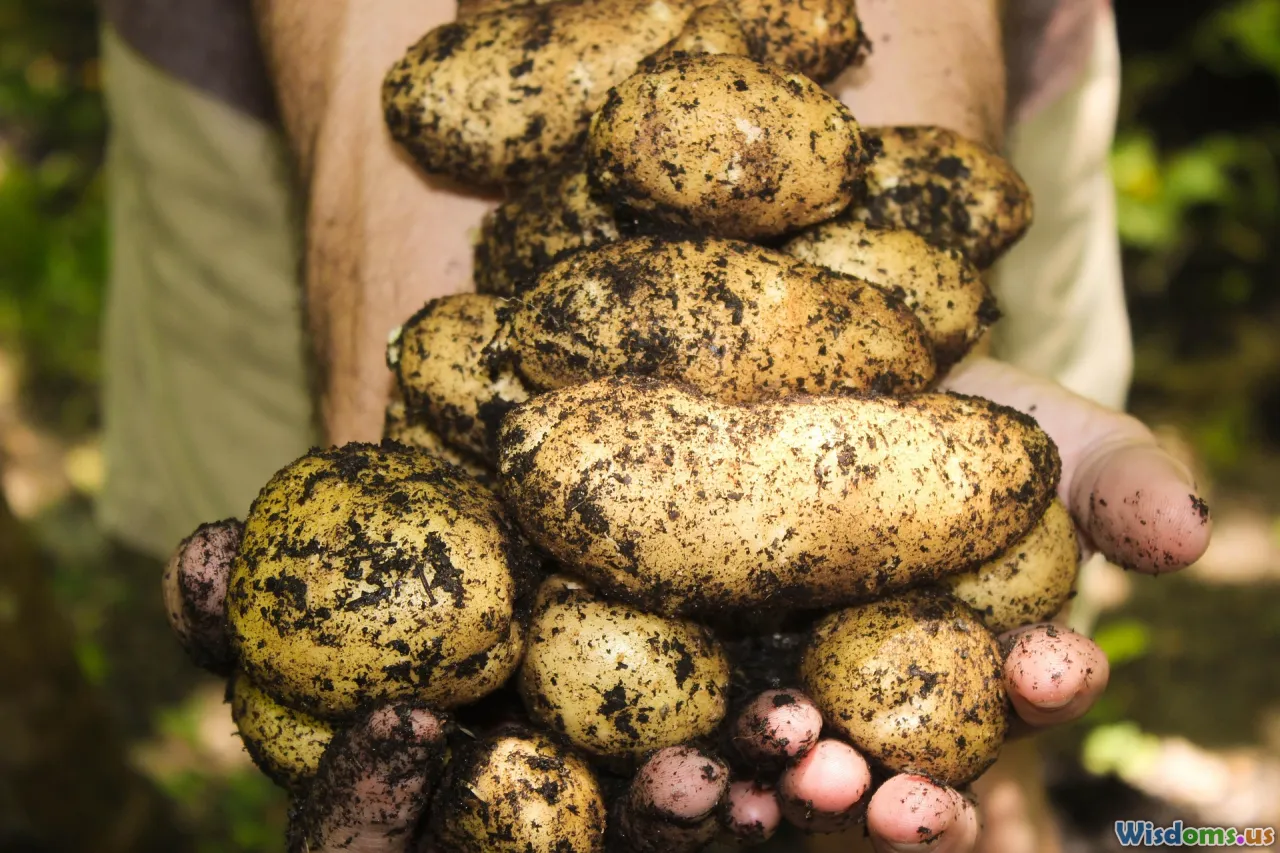
Can Urban Gardening Really Lower Your Carbon Footprint?
15 min read Explore how urban gardening impacts your carbon footprint and supports sustainable cities with real examples and actionable tips. (0 Reviews)
Can Urban Gardening Really Lower Your Carbon Footprint?
Cities surge and swell with life—commuters drift by on crowded streets, skyscrapers slice the horizon, and the ambient hum rarely fades. In this modern mosaic, one might assume that carbon footprints are predestined to grow. Yet, an old solution is weaving its way into new spaces: urban gardening. For some, tending a tomato vine on a balcony feels worlds away from global climate action. For others, it's a vital step toward sustainability. Can this green movement genuinely carve into the carbon output of our urban jungles? Let's turn the spade and dig deep.
Why Carbon Footprints Matter in Cities

Concrete, public transport, offices, homes; wherever people cluster, carbon emissions rise. Nearly 70% of global CO₂ emissions originate from cities, driven by energy-guzzling buildings, traffic, and behind-the-scenes logistics required to keep society humming.
But urban areas hold an unlikely advantage: density. Proximity enables efficient systems and pioneering behaviors. The carbon footprint—the total greenhouse gases emitted to support human lifestyles—thus becomes both a challenge and an urgent opportunity in metropolitan settings. Mitigating emissions at the city scale could have compounding benefits, affecting not just residents but the climate as a whole.
Example: New York City, with all its energy demands, paradoxically boasts lower per-capita emissions than suburban areas, thanks to walkability, public transit, and, increasingly, local sustainability movements—such as community gardens cropped up in reclaimed lots from the Bronx to Brooklyn.
What Is Urban Gardening? Modern Takes on an Ancient Practice

Urban gardening is more than placing a potted basil on your windowsill—although that counts, too! It ranges from homegrown herbs to sophisticated rooftop farms skimming clouds atop busy boulevards. These spaces bring food and flowers where there's little earth—balconies, courtyards, abandoned lots, vertical walls, and community parks. Methods might include container growing, hydroponics, raised beds, and even aquaponic setups integrating fish.
Concrete Examples:
- Rooftop gardens: Affordable Housing Initiative in Toronto mandates green roofs, often used for growing vegetables.
- Community plots: Los Angeles' Green Grounds transformed vacant neighborhood lots into food streams for residents.
- Vertical farming: Singapore’s Sky Greens stacks leafy greens in rotating towers, maximizing output per square foot.
This resurgence is driven by food trends, environmental awareness, and often, necessity. During the Covid-19 pandemic, for example, 2020 saw seed sales triple worldwide as homebound residents embraced gardening not just as a hobby, but for its tangible benefits.
The Urban Food System’s Hidden Carbon Cost

Most city dwellers rely on complex, global food networks to deliver produce to their plates. The average North American meal, studies show, travels 1,500 miles from farm to table. The greenhouse gas cost accumulates at every stage:
- Industrial farming (fertilizers, pesticides, tilling)
- Transportation by diesel trucks, container ships, and planes
- Packaging (especially plastic)
- Refrigeration and retail operations
- Food waste throughout the supply chain
For example: The UK’s DEFRA estimates that food and drink supply chains account for 19% of the country’s total greenhouse gas emissions. When a tomato is flown in from abroad, it might emit over 10 times the carbon compared to a locally grown, in-season variety.
Urban gardening disrupts this chain: an eggplant grown on your patio skips thousands of transportation and refrigeration miles, isn’t doused in transit chemicals or thick plastics, and is unlikely to go uneaten.
Carbon-Crunching Benefits of Urban Gardens

Urban gardening offers several direct and indirect ways to chisel away at carbon footprints:
1. Reduced Food Miles
Homegrown food leaps straight from garden to kitchen.
Fact: A 2014 study found that lettuce grown on Chicago rooftops traveled 99% fewer miles than store-bought.
2. Fewer Packaging & Preservatives
Just-picked produce skips the energy-intensive cycles of sorting, washing, packaging, and gassing for preservation. That’s fewer single-use plastics and chemicals.
3. Lower Food Waste
Gardeners pick only what’s needed. Bruised fruit isn’t discarded as unsellable; it lands, free of guilt, in a salad or stir-fry.
4. Soil Sequestration
Compost bins in urban gardens convert household food scraps into fertile soil, retaining carbon and cutting methane emissions from landfilled organics. Rich soils also act as mini-carbon sinks, absorbing atmospheric CO₂.
5. Cooling Metropolitan Heat
Vegetation cools cities through shading and evapotranspiration. The EPA reports that green roofs can reduce surface temperatures by up to 40°C (104°F) compared to conventional roofs—lowering building energy demands.
6. Supporting Urban Biodiversity
Greening spaces create habitats for pollinators and beneficial insects, bolstering resilience in urban ecosystems that often run on precariously thin biological margins.
How Much Can Urban Gardening Actually Reduce Emissions? (By the Numbers)

Quantifying the carbon savings of urban gardening isn’t straightforward — it hinges on what’s grown, what’s displaced, and how the garden is managed. However, research can sketch out a picture:
- On average, growing 1kg of vegetables at home displaces 2-3kg of commercial CO₂ emissions. According to a 2022 study in Environmental Research Letters, a small 10-square-meter urban plot could save roughly 50-80kg CO₂ per year if it replaces purchased store-bought veggies of equal weight.
- Composting kitchen waste reduces household landfill emissions by about 50kg CO₂/year, as per the Carbon Trust. This effect multiplies neighborhood-wide.
- Green roofs that double as gardens can reduce building energy needs by up to 7%, which feeds back into overall emissions cuts for urban energy grids.
Comparative Example
Suppose a family of four in an apartment block commits to growing greens, tomatoes, and herbs in containers amounting to just 2 square meters. By harvesting fresh, packaging-free salad ingredients for six months of the year, they could trim their food-related carbon footprint by up to 150kg of CO₂ annually—the equivalent of driving an average car nearly 370 miles.
Multiply that by even 1% of households in a typical city like Berlin, and you’re diverting tens of thousands of tons of emissions annually from the atmosphere.
Non-Carbon Benefits for Cities and Communities

The lure of urban gardening isn’t limited to numbers on a carbon balance sheet—it stitches in copious social and health dividends:
- Mental wellness: The Royal Horticultural Society found that people active in gardening report lower anxiety, depression, and stress.
- Community cohesion: Shared gardens reclaim underused land, bring neighbors together, and foster food literacy in children.
- Increased food security: For lower-income families and marginalized groups, these gardens become a lifeline for nutrient-rich (and chemical-free) produce.
- Resilience: Urban green spaces dampen flooding, improve air quality, and soften city noise, creating healthier, more adaptable communities.
Barriers and Misconceptions About Urban Gardening’s Impact

Despite all the pluses, urban gardening’s full carbon-busting potential is blunted by legitimate constraints and misunderstandings:
- Space limits: Not every apartment has even a sun-drenched sill; rooftops require investments and engineering.
- Soil and water contamination: City soils can be tainted with heavy metals; raised beds run on imported soils, which may carry their own carbon costs.
- Scaling up: Most rooftops and balconies can supply a fraction of a household’s caloric needs. Staples (grains, legumes) require large plots to grow efficiently.
- Myth of perfection: Urban gardening alone can’t supplant large-scale agriculture nor erase food system emissions.
That said, urban gardening’s impact compounds with wider change: it nudges cities toward circular systems, supports local food entrepreneurs, and elevates food consciousness among consumers.
Practical Ways to Maximize Your Garden’s Carbon Savings

How can you, the city dweller or aspiring garden visionary, ensure your tiny plot of green has maximum climate impact? Consider these tried-and-tested strategies:
-
Favor Veggies with High Carbon Payoff: Leafy greens, tomatoes, herbs, and climbing beans are productive and nutrient-dense, offering the most CO₂ savings relative to space.
- Tip: Avoid heavily fertilized crops if sourcing commercial soils—opt for local, organic amendments instead.
-
Practice Composting: Transform all kitchen scraps (except meat/dairy) into compost—feed your soil, shrink landfill methane, amplify soil-carbon capture.
-
Optimize Water Usage: Install a rainwater barrel; choose drought-tolerant cultivars; minimize runoff.
-
Go Peat-Free: Traditional bagged compost contains peat, the extraction of which is a major carbon source. Look for peat-free alternatives.
-
Encourage Biodiversity: Grow a mix of flowers and edibles; native plants attract pollinators, support resilience, and create miniature refuges.
-
Share and Scale: Join or organize a community garden, swap cuttings, share harvest abundance to avert food waste economy-wide.
Real-World Model: In Detroit, the non-profit "Keep Growing Detroit" supports over 1,900 community and backyard gardens, providing seedlings, compost, and education—collectively offsetting hundreds of tons of CO₂ each year, and regenerating city neighborhoods once emptied by deindustrialization.
The Tipping Point: Urban Gardening as a Catalyst for Broader Change

Urban gardening—while lacking the capacity by itself to undo the entire carbon output of the metropolis—acts as a critical spark. It helps decipher the true cost of food, reconnects residents with land even in the densest environments, and fosters behaviors (like composting, waste reduction, and community shopping) that radiate through households and city systems.
Cities like Paris are doubling down: by 2020, over 30 hectares of Parisian rooftops and walls sprouted with urban gardens (the city’s "Parisculteurs" initiative). Local food movements nudge policymakers, spawn micro-businesses, and help reset urban planning priorities toward greener, circular climates.
Ultimately, every seed, sprout, shoot, or fruit raised in an urban garden disrupts the usual calculus of consumption and waste. With enough initiative and imagination, urban gardening has a real—and growing—role to play in trimming the carbon footprints of our cities, one planter box at a time.
Rate the Post
User Reviews
Popular Posts




















